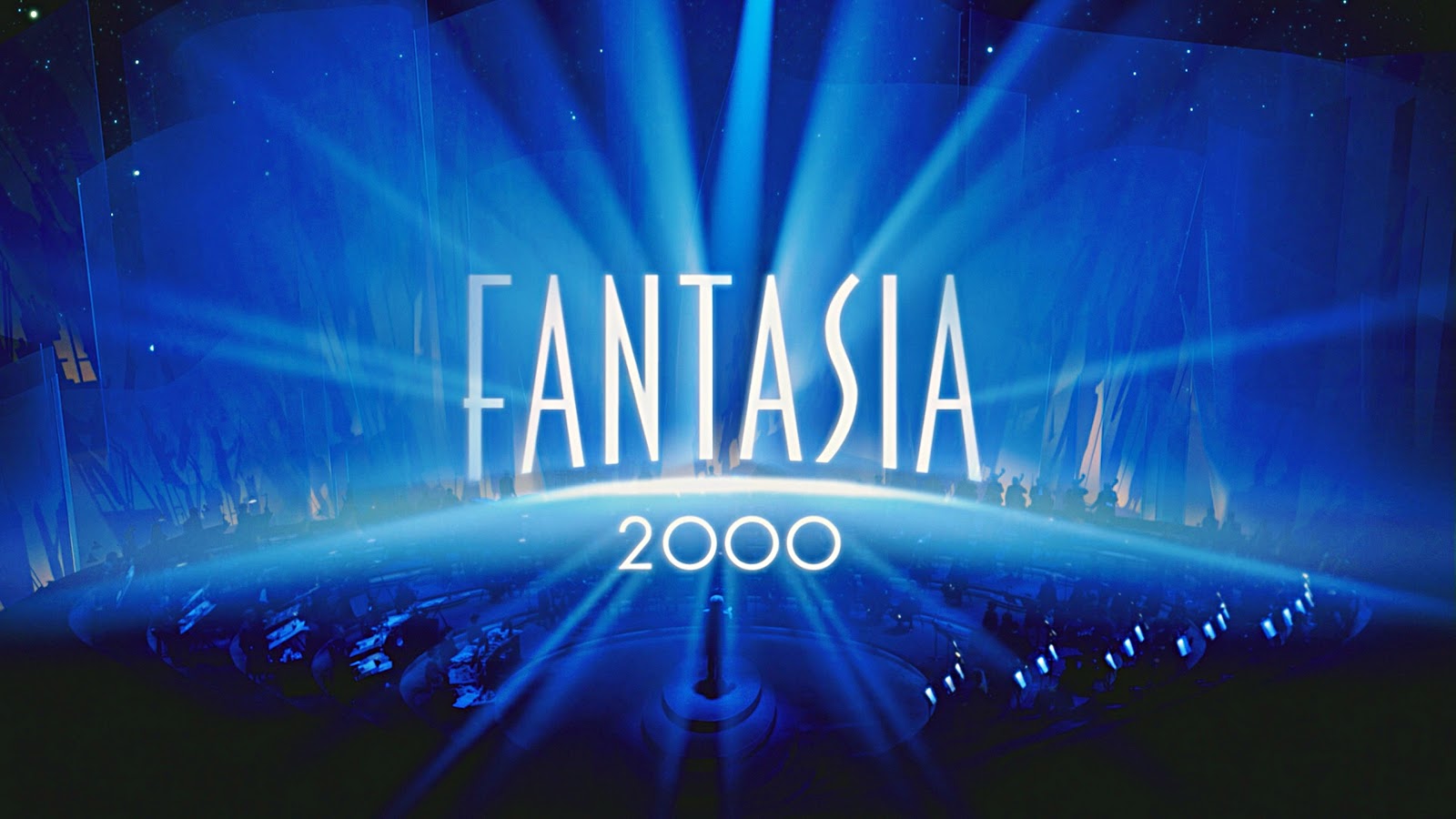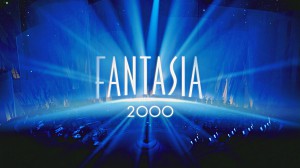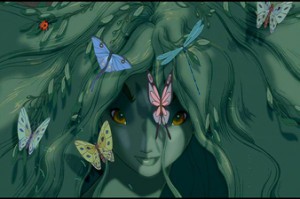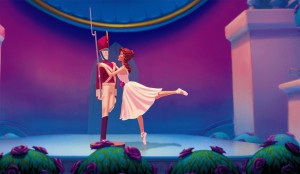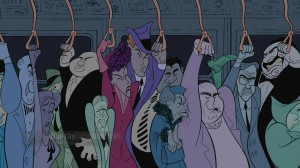“I think we’re all glad that they changed the name to Fantasia,” states Steve Martin dryly during his introduction of Fantasia 2000 regarding the film’s predecessor, which was originally called The Concert Feature. (Fantasia may be a slightly cooler-sounding title, but it’s not much more inviting to the average audience member than The Concert Feature.) That single line of dialogue represents the key to the creative struggle at the heart of Fantasia 2000, a perfectly entertaining film with no identity of its own. Though Martin is funny in his few moments on screen (all of the celebrity introductions in this new film are mildly charming in their own way, though they vary in tone from Martin’s wacky fourth-wall-breaking humor to regal sincerity, as with Angela Lansbury’s climactic appearance), the fact that a recognizable comedian needs to be one of our ushers into a world of strange and fascinating new animation is a tip-off that Fantasia 2000 doesn’t even hope to achieve the same lofty ambitions Fantasia had. The shorts themselves do not reek of hipness and irony, but with Martin’s appearance (even though he was once a cast member at Disneyland, well before he was a stand-up), the movie appears to be catering more to a presumed audience of kids and young adults that tacitly refuses to accept sincerity in art.
Its flaws aside (and like Fantasia, it is imperfect), this much is clear: whatever we consider to be the commonly established Disney Renaissance, Fantasia 2000 must be included among the entries. The etymology of that term isn’t 100% clear: a few early online articles utilize the phrase “Disney Renaissance,” which typically refers to an era spanning from The Little Mermaid to Tarzan. Though it is notoriously unreliable, the era’s Wikipedia page allows for a pre- and post-Renaissance period, including such films as The Black Cauldron, The Great Mouse Detective, Oliver & Company, and Fantasia 2000, but the official Renaissance films do not include this sequel, without any good reason. The era is argued to extend from 1989 to 1999, but few would debate against the period’s pinnacle ending in 1994, with The Lion King. If, then, the period is not solely defined by the perceived exceedingly high quality of its entries, what denotes inclusion? There is no defined criteria, only the generally correct assumption that the majority of Walt Disney Animation Studio’s output in the 2000s was of a poorer quality than, say, Beauty and the Beast. Fantasia 2000, in spite of its title, is technically a 1999 release, having been unveiled in a special engagement in mid-December in New York and Los Angeles. Its wide release in IMAX theatres was on New Year’s Eve 1999. Of the seven films that followed Fantasia 2000 before Disney temporarily washed their hands of traditional animation in 2004, only Lilo & Stitch has inspired a serious fanbase. So while it may be true that the Disney Renaissance culminated in 1999, it’s patently incorrect that the period must have ended with Tarzan.
Fantasia 2000, as alluded above, is far from perfect. As ambitious as its forebear was, this is a lighter and more accessible product, a film with less new animation on the whole than in the first half of Fantasia. (Including “The Sorcerer’s Apprentice,” which ended up being the only old short to find its way onto the new program, there’s just over 60 minutes of animation in Fantasia 2000. Removing “The Sorcerer’s Apprentice,” there’s just over 50 minutes, while the first half of Fantasia has over 52 minutes.) The celebrity introductions make sense—is there even a modern-day equivalent to Deems Taylor?—and yet, they reek of safety. And many of the new shorts feel as if they were designed to appeal to children first, and sometimes only children. (The “Carnival of the Animals” scene is very whimsical, but also very juvenile, and not as layered as the “Dance of the Hours” sequence in Fantasia, which similarly aims at playfully skewering high culture by invoking its polar opposite.) And there’s not just one familiar Disney character on display, but two, with Donald Duck toplining the “Pomp and Circumstance” number.
So yes, Fantasia 2000 may be not flawless, but its parts fit together very nicely and confidently. If we can criticize the film for not being as highfalutin as its predecessor, we must also applaud it for being exceptionally coherent. The whole, not just the parts, are a bit more kid-friendly in spite of being thoroughly delightful. The film’s aims may not be astronomical, but they are no less successful in being met. What Fantasia 2000 may lack in a high reach, it compensates for by being purely enjoyable in ways that the original Fantasia isn’t. There’s a level of bombast in each musical choice–even the instantly familiar compositions like “Rhapsody in Blue”–that, coupled with the colorful and thrilling animation, combines to create as much of an experiential film as the 1940 original.
There are, admittedly, more creatively ambitious story-based films in the Disney Renaissance, such as the one-two punch of Pocahontas and The Hunchback of Notre Dame, both of which essentially aimed for the fences and struck out painfully. Both of these pictures have some of the best music of the Disney Renaissance, next to the iconic Alan Menken/Howard Ashman magic in The Little Mermaid, Beauty and the Beast, and parts of Aladdin. Like Fantasia 2000, the animation is frequently breathtaking; Fantasia 2000’s constant blend of computer and traditional animation is, even now, shockingly seamless, considering that a couple of the shorts were completed before the release of the first Toy Story. Pocahontas and The Hunchback of Notre Dame, though, have pleasantly lush and impressionistic touches throughout, welcome bits of stylization that represent a throwback to the early days of Disney, as when they concocted the psychedelic-before-psychedelia-was-mainstream “Pink Elephants on Parade” sequence in Dumbo. (No doubt, there are a few such moments in Fantasia 2000, such as in the opening sequence scored to Beethoven’s “Symphony No. 5 in C Minor,” and the “Pines of Rome” number, but there’s more coherence to the images here.)
And both Pocahontas and The Hunchback of Notre Dame, unlike Fantasia 2000, are lined with unmistakably poor, misbegotten storytelling decisions. The latter, for instance, succeeds in one of its most complex and mature choices, depicting Judge Frollo, the antagonist, as a pious man being rent apart by his undeniable lust for the gypsy woman Esmeralda. The song “Hellfire,” which he sings to a literal fire that eventually takes the form of this alluring creature, is not only an artistic leap forward for Disney’s animators, but an ingenious and intelligent grace note in the story. And Quasimodo’s fruitless desire for companionship, initially met by his growing attraction to Esmeralda, is well captured precisely because of how bittersweet its outcome is. Both of these moments, however, are bookended by fart jokes, talking gargoyles, and a preponderance of modernized jokes and voice work. (Esmeralda, as beautiful as she’s rendered, has Demi Moore’s voice, which is far too 1990s-sounding for a period piece.) The Hunchback of Notre Dame is divided between attempting to faithfully adapt Victor Hugo’s tragic novel to the big screen, and attempting to be a Disney movie. Enough of the former aspiration is present in the final product that it slightly overshadows the latter goals, but only slightly. Pocahontas is a bit less aggressive in appealing to a younger crowd—there are cheerful-looking animal sidekicks, both to the title character and the sniveling Governor Ratcliffe, but they stay silent throughout—and is a bit more grounded in reality; still, its star-crossed love affair is rendered flat and inert, in spite of being that rare beast in mainstream cinema, an interracial romance.
Of course, it’s important to acknowledge the flaws of Fantasia 2000, even outside of its lowered ambitions. We can excuse them mostly, at least, by appreciating that the film’s existence is something of a miracle and likely was only enabled because of the towering success of early Disney Renaissance films. Michael Eisner may have appreciated the creative side of the company he ran to a certain degree, but he was a businessman first and, by the mid-1990s, it was less than a sure thing to greenlight a dialogue-free film with animated shorts set to classical music, a rarity by the end of the century. It is, however, impossible to not compare Fantasia 2000 to Fantasia, and though both attempt to marry high and low culture, too often, the newer film feels top-heavy with the latter. Watching the esteemed conductor James Levine roll his eyes at having to stall while Mickey Mouse searches for Donald Duck, who’s in the shower before his big number begins, is funny, but radically different from the almost staid emcee moments in the 1940 film. While Deems Taylor’s various stilted introductions may seem tonally inappropriate to modern audiences, he fits far better with the tone of the earlier film than do Martin, Penn & Teller, and Bette Midler. (Midler’s brassy and brash attitude, particularly, feels inappropriate to her introduction of “The Steadfast Tin Soldier,” as she appears to be scoffing at some past discarded ideas and half-produced shorts that nearly made their way into a Fantasia picture, including one from Salvador Dali. “You know, the melting clocks guy?” to quote Ms. Midler.)
The shorts themselves are impressively animated, though a few seem as if they were designed as filler. The “Carnival of the Animals” scene, for instance, is fast-paced and funny in spite of its immaturity, but it’s barely 2 minutes long. As a demonstration of longtime Disney animator Eric Goldberg’s prowess, it’s excellent, but considering that even the gag where Deems Taylor interacts with the soundtrack in Fantasia is longer than this entire segment, it’s something of a letdown. More enjoyable, though, is spotting the parallels, deliberate or not, between the shorts here with those in the original film. The “Pomp and Circumstance” number, which re-envisions the story of Noah’s Ark from the perspective of Noah’s “helper,” Donald Duck as well as his nearly lost love Daisy, is a more aggressively religious sequence than the “Ave Maria” scene that closes out Fantasia, if only because the presence of God is much more visible in the former. (Here, of course, God is used to punctuate a punchline, whereas the “Ave Maria” scene is intentionally humor-free.) But the ensuing “Firebird Suite” scene, which functions as the finale of Fantasia 2000, is as close a distillation of the theme of an all-encompassing evil being blotted out through a rebirth and renewal of spirit as is seen in the “Night on Bald Mountain”/”Ave Maria” twofer climax. And the opening number occupies the same abstract plane as does the “Toccata & Fugue” opener of Fantasia.
The downside to some of these parallels is that Fantasia 2000, as the only follow-up to date to Fantasia, is constantly trying to get out from the earlier film’s shadow. Though it echoes Fantasia in many ways, often to at least pay respect to the original, Fantasia 2000 wants to seem more current, actively attempting to ground itself in the present as opposed to letting that feeling occur naturally. The best short in the bunch, “Rhapsody in Blue,” also directed by Goldberg, defiantly stands apart from any modernization. Set in a stylized late-30s/early-40s version of New York City, the short takes its visual cue from the late artist Al Hirschfeld, who was well-known for his outlandish yet surprisingly insightful caricatures of celebrities throughout the 20th century. Unsurprisingly, the story is told in similarly broad strokes; the four leads include an Eloise-like little girl who would rather spend time with her workaholic parents instead of being forced to take piano lessons, ballet class, etc.; a squat little man under the thumb of his big, blustery harridan of a wife; a down-on-his-luck young black man who makes a living in construction but wants desperately to make a living as a jazz drummer in Harlem; and the iconic unemployed middle-aged man, his eyes sunken with rejection and hopelessness. That there is an easy, happy ending for all of these people—the girl and her parents reunite at the end, the henpecked hubby frees himself from his wife and dances in the same jazz hall where the young man begins drumming for a living, and the vagrant winds up with that young man’s construction job—doesn’t dull the short’s overall power.
Just as Fantasia is indescribably important to the legacy of Disney animation—and, along with Snow White and the Seven Dwarfs, Pinocchio, Dumbo, and Bambi, is rightly considered as part of the first Disney golden age of animation—so too is Fantasia 2000. The history of the term “Disney Renaissance” is vague and ill-defined, and its usage often doesn’t denote all of the films in the era, simply a few that most audiences worldwide love as much as the story of Cinderella, Sleeping Beauty, or Peter Pan. It is doubtful that most people who refer to the Disney Renaissance do so in conjunction with the first Disney animated sequel (and, along with Fantasia 2000, one of the only sequels that was both released theatrically and considered canon), The Rescuers Down Under. More likely, someone might be surprised to realize that 1990 sequel, which had the misfortune of opening in theaters on the same day as Home Alone, is technically part of a group including Beauty and the Beast and The Lion King. If we are meant to group Disney’s animated films into various chronological chapters, then specific ground rules need to be laid down and established. As of now, there’s no good reason why the Disney Renaissance ends with Tarzan, a film most people haven’t held in high esteem over the years, if they’d held it in any esteem at all. That it officially started with The Little Mermaid makes sense. Why, then, shouldn’t the Disney Renaissance go out on a nearly literal high note? Fantasia 2000, an imperfect addition to the animated feature canon and a consistently loose and enjoyable follow-up, is that high note. Let us consider this charming, colorful film among the chosen few of the Disney Renaissance, from this point forward.
— Josh Spiegel

